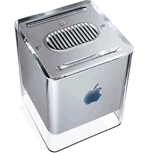Computing News
Apple’s G4 Cube

Steve Jobs introduced the G4 Cube (officially called the Power Macintosh G4 Cube) systems on July 20, 2000 at MacWorld Expo New York. The G4 Cube introduces a new, approximately 8-inch square form factor to Apple's product line.
Specifications
- 100 MHz system and 66 MHz PCI bus
- Three SDRAM slots, allowing up to 1.5 GB of RAM
- 10/100BaseT Ethernet
- Two 12 Mbps USB ports for connecting low-speed devices
- Two 400 Mbps FireWire ports for connecting high-speed devices
- A standard ATI 3D Rage 128 card that provides video in a 66 MHz/32bit graphics slot with 16 MB SGRAM with a VGA connector and an Apple Display Connector (which only works with brand new Apple Displays)
- Two Harmon Kardon digital USB speakers
- Mac OS 9.0.4, a USB keyboard (the new Pro Keyboard), and a USB mouse (the new Pro Mouse)
What they don’t have (compared to a G4 minitower)
- PCI card slots (this means that popular upgrades such as an internal SCSI card are unavailable)
- Drive expansion slot (this means that the ISC recommended internal Zip drive is not an option)
Standard configuration
The standard configuration, available at the Computer Connection, is:
- 450 MHz G4/64 Mbytes RAM/20 Gbyte hard drive
Technical issues & recommendations
Please note that digital monitors other than the current Apple Studio Displays will not work with the G4 cube. Apple and various third parties have promised an adaptor, but pricing and specifications are not yet available.
Aside from the incompatibility with digital monitors, ISC does not expect there to be significant hardware-related compatibility problems with the G4 Cube. However, the G4 Cube will have the same software-related conflicts that any Mac OS 9.x workstation would have.
ISC has tested the G4 Cube for compatibility with University supported hardware and software, including the PennConnect 2000 CD-ROM. Special attention was paid to dial-up networking and modem functionality, which was tested using a slightly modified version of ISC’s modem testing script.
These workstations meet all of ISC’s desktop recommendations for Macintoshes, with the addition of extra RAM and an external Zip drive. As always, support providers should be aware of the technical issues associated with any new workstation design.
--John Mulhern III, IT Project Leader, ISC Provider Desk
[an error occurred while processing this directive]
[an error occurred while processing this directive]